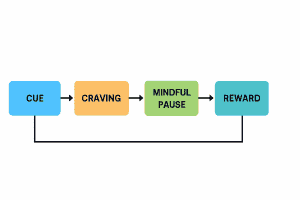
Habits are formed through a simple loop made up of three parts: a cue, a routine, and a reward. This idea was popularised by Charles Duhigg in his book “The Power of Habit.”
It all starts with a cue, which is something that triggers a certain behaviour. This could be anything, such as a specific time of day, a particular feeling, or your current location. Next comes the routine, which is the actual behaviour or action you take after noticing the cue. This could be something small, like grabbing a snack, or something bigger, like going for a workout.
Finally, there’s the reward, which is the positive feeling you get after doing the routine. This could be something you feel inside, like happiness, or something you receive, like a treat.
Together, these steps create strong loops that shape our habits, making them easier to do over and over again. By understanding how this process works, people can learn to build good habits and break bad ones more effectively. – Hypnosis intervenes at the cue stage: “When I see the cigarette pack, I instantly feel a wave of calm instead of craving.”
Many individuals seek to enhance their well-being by addressing specific habits and behaviours that they find detrimental. For instance, quitting smoking often ranks as a top priority due to the numerous health risks associated with tobacco use, including respiratory diseases and cardiovascular issues.
Similarly, minimising nail-biting is a common goal for many, as this habit not only affects the appearance of one’s hands but can also lead to dermatological problems and infections. By identifying stressors or triggers, individuals can work on anxiety reduction techniques to curb this behaviour.
Additionally, reducing excessive scrolling on digital devices has become increasingly important in our technology-driven society. This behaviour can lead to diminished mental health, increased feelings of loneliness, and disrupted sleep patterns. Initiatives such as setting specific time limits for device use or engaging in alternative activities can help people regain control over their screen time and foster more meaningful interactions in their daily lives.
Graphic: Flowchart of a habit loop: Cue → Craving → Response → Reward. Then show how hypnosis inserts a “Mindful Pause” between cue and response.

